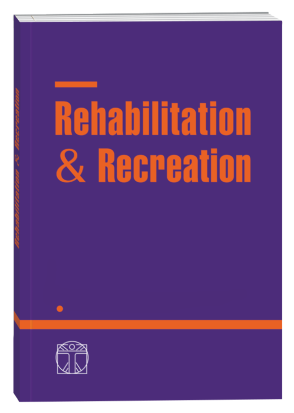INFLUENCE OF PHYSICAL THERAPY ON INDICATORS OF POSTURAL STABILITY, FALL RISK AND KINESIOPHOBIA IN OLDER AGE GROUP PATIENTS WITH BILATERAL HIP ARTHROPLASTY IN THE LONG-TERM REHABILITATION PERIOD
DOI:
https://doi.org/10.32782/2522-1795.2025.19.2.2Keywords:
physical therapy, bilateral arthroplasty, arthroplasty, hip joint, lower limb, risk of falling, old ageAbstract
Objective – to evaluate the effectiveness of the developed physical therapy program on the indicators of postural stability, risk of falling and kinesiophobia in patients of older age groups with bilateral hip replacement in the long-term rehabilitation period. Material. 112 elderly people (69.6±1.2 years) were examined. The control group consisted of 42 people who had no history of lower limb joint replacement. The comparison group consisted of 37 people with unilateral total hip replacement. The experimental group consisted of 33 people with bilateral hip replacements, the effectiveness of which is presented in our study. A three-month physical therapy program was developed and implemented for them with the use of therapeutic exercises (using weighted weights, Thera-Band, MFT Challenge Disc Digital); gait training (self-control, practicing gait phases, overcoming an obstacle course), functional training of symmetry of lower limb movements (PROCEDOS PLATFORM 9 platform), Nordic walking; educational component – learning to control one’s condition, movement limitations, reducing the risk of falling, awareness of the need for regular rehabilitation interventions; reshaped physical factors – electromyostimulation of the quadriceps femoris muscle, gluteal muscles, and calf muscles. The effectiveness was assessed by the results of stabilometry, Fall efficacy scale, Timed Up & Go test, Tampa Kinesiophobia Scale. Results. Elderly patients with bilateral hip replacement in the long-term rehabilitation period showed deterioration of postural stability (according to the results of stabilometry), risk of falling (Fall efficacy scale, Timed Up & Go test, kinesiophobia (according to Tampa Kinesiophobia Scale); according to the studied indicators, their condition was worse (p<0.05) than in individuals with one hip replacement and the control group. The approved comprehensive physical therapy program of duration showed improvement of the patients’ condition due to the impact on the components of the balance function due to the improvement of postural stability, reduction of the risk of falling and kinesiophobia compared to the initial indicators according to all the studied parameters (p<0.05). Conclusions. Physical therapy is advisable to prescribe for the complex correction of signs of postural dysfunction, risk of falling and kinesiophobia in elderly patients with bilateral hip replacement joints.
References
1. Aravitska M.H., Saienko O.V. The influence of physical therapy on indicators of locomotive syndrome in elderly persons with osteoarthritis of the knee and obesity. Clinical and Preventive Medicine. 2023. № 4(26). Р. 6–13. https://doi.org/10.31612/2616-4868.4(26).2023.01.
2. Chen X., Li X., Zhu Z., Wang H., Yu Z., Bai X. Effects of progressive resistance training for early postoperative fast-track total hip or knee arthroplasty: A systematic review and meta-analysis. Asian J Surg. 2021. № 44(10). Р. 1245–1253. doi: 10.1016/j.asjsur.2021.02.007.
3. Guo S.J., Shao H.Y., Huang Y., Yang D.J., Zheng H.L., Zhou Y.X. Retrospective Cohort Study Comparing Complications, Readmission, Transfusion, and Length of Stay of Patients Undergoing Simultaneous and Staged Bilateral Total Hip Arthroplasty. Orthop Surg. 2020. № 12(1). Р. 233–240. doi: 10.1111/os.12617.
4. Huang L., Xu T., Li P., Xu Y., Xia L., Zhao Z. Comparison of mortality and complications between bilateral simultaneous
and staged total hip arthroplasty: A systematic review and meta-analysis. Medicine (Baltimore). 2019. № 98(39). Р. 16774. doi: 10.1097/MD.0000000000016774.
5. Katz J.N., Arant K.R., Loeser R.F. Diagnosis and Treatment of Hip and Knee Osteoarthritis: A Review. JAMA. 2021. № 325(6). Р. 568–578. doi: 10.1001/jama.2020.22171.
6. Kurishima H., Yamada N., Noro A., Tanaka H., Mori Y., Aizawa T. Comparison of outcomes and cost-effectiveness of simultaneous and staged total hip arthroplasty using the anterolateral-supine approach. J Orthop Surg Res. 2025. № 20(1). Р. 424. doi: 10.1186/s13018-025-05840-x.
7. Rakaieva A.E., Aravitska M.G. Study of the effectiveness of rehabilitation intervention for the correction of symptoms of astenovegetative syndrome in elderly persons with the consequences of coronavirus infection. Rehabilitation and Recreation. 2024. № 18(3). Р. 41–50. https://doi.org/10.32782/2522-1795.2024.18.3.4.
8. Rakaieva A.E., Aravitska M.G. Correction of the geriatric status associated with impaired muscle activity in the elderly with post-COVID-19 syndrome by physical therapy means. Ukraine. Nation’s Health. 2024. № 1. Р. 172–178. doi: 10.32782/2077-6594/2024.1/30.
9. Ramezani A., Ghaseminejad Raeini A., Sharafi A., Sheikhvatan M., Mortazavi S.M.J., Shafiei S.H. Simultaneous versus staged bilateral total hip arthroplasty: a systematic review and meta-analysis. J Orthop Surg Res. 2022. № 17(1). Р. 392. doi: 10.1186/s13018-022-03281-4.
10. Szilágyiné Lakatos T., Lukács B., Veres-Balajti I. Cost-Effective Healthcare in Rehabilitation: Physiotherapy for Total Endoprosthesis Surgeries from Prehabilitation to Function Restoration. Int J Environ Res Public Health. 2022. №. 19(22). Р. 15067. doi: 10.3390/ijerph192215067.
11. Tyrpenou E., Megaloikonomos P.D., Epure L., Huk-Papanastassiou O., Zukor D., Antoniou J. Similar complication and readmission rates following simultaneous versus staged bilateral total hip arthroplasty. Eur J Orthop Surg Traumatol. 2024. № 34(2). Р. 863–867. doi: 10.1007/s00590-023-03734-4.
12. Zhu S., Qian W., Jiang C., Ye C., Chen X. Enhanced recovery after surgery for hip and knee arthroplasty: a systematic review and meta-analysis. Postgrad Med J. 2017. № 93(1106). № 736–742. doi: 10.1136/postgradmedj-2017-134991.
Downloads
Published
How to Cite
Issue
Section
License

This work is licensed under a Creative Commons Attribution-NonCommercial-NoDerivatives 4.0 International License.





